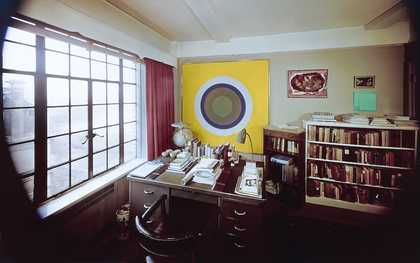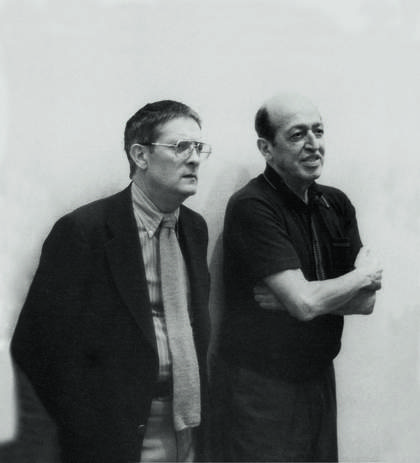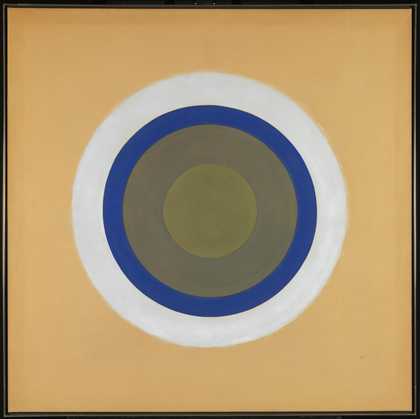
Kenneth Noland's Gift 1961–2 in Clement Greenberg's apartment, New York, 1963, photographed by Hans Namuth
Photo: Hans Namuth / Condé Nast via Getty Images. Artwork © Estate of Kenneth Noland. DACS, London / VAGA, New York 2017
Kenneth Noland’s Gift started its life as just that. Painted in the artist’s studio in New York’s Chelsea Hotel, Noland gave the work as a present to his friend and long-time supporter Clement Greenberg, the influential New York art critic. As a 1963 photograph reveals, it hung for a time above Greenberg’s desk. Even amid the bookish clutter of his study, the throbbing design of the canvas dominates. It must have been an overwhelming presence, the kind of painting that refuses to blend into the background.
Knowing that this particular piece loomed over Greenberg’s place of work, one wonders if it also made its presence felt in the critic’s essays of the period. It certainly conforms to his preference for the kind of flat and abstract compositions on raw canvas made by Noland and fellow Washington painter Morris Louis, artworks that Greenberg thought pointed the way forward for serious modernist painting.
First known as Clement’s Gift, the work’s original title might even be understood to praise the famously gifted eye of the critic. If it did, Greenberg returned the favour by including the painting (under the new, more anonymous title of Gift) in the exhibition Three American Paintings that he curated in 1963, and by loaning it for the United States pavilion at the Venice Biennale in 1964. Eventually, Noland swapped Greenberg’s painting for another work, and donated Gift to Tate, where it became his second circle painting to enter the collection.
Like many artworks, before Gift was shown on the white walls of a public museum it was viewed in a rather more everyday setting. It is a reminder that Greenberg’s views on art were shaped not only by his critical judgments, and the artistic friendships they sometimes produced, but also by the experience of living with modern art. ‘Big paintings turn out to be astonishingly easy to live with,’ he explained of his collection in 1964. ‘A picture that works seems to fit in anywhere.’

Kenneth Noland (left) with Clement Greenberg (right), c.1970s
While detractors of abstract painting might have dismissed such art as ‘mere decoration’, its advocates could celebrate these same decorative qualities. For a 1960 exhibition of circle paintings, for example, Noland’s dealer, Washington-based Alice Denney, actively promoted their suitability for home decor. ‘I think people are going to buy paintings to cover whole walls ... the day of wallpaper will be over,’ she declared, suggesting that one of the artist’s eight-foot canvases would work especially well on the ceiling.
In the late 1950s Noland had even exhibited in an interior design shop, where his paintings were displayed alongside lamps, plants and ‘simple furniture with strong, bright colours’. Of this show, he highlighted the decorative potential of his art. ‘Most people are afraid to buy a large abstract, says artist Noland, since they feel it will overpower their homes,’ the Washington Post reported. ‘Actually one of these decorative paintings can fill up an entire wall and blend in with the room’s colour scheme.’
As Noland came to be recognised as a key figure in what Greenberg called ‘post-painterly abstraction’, and others still dubbed ‘hard-edge painting’ (though his edges are, close up, often rather fuzzy), the connections between his paintings and home decor were largely erased from art historical memory. But perhaps our understanding of the meanings of abstract art might now be expansive enough to accommodate home decoration as one of its many values... and one that need not distract from its seriousness or ambition.

Kenneth Noland
Gift (1961–2)
Tate
© The estate of Kenneth Noland /VAGA, New York/DACS, London 2025
Gift was presented by the artist through the American Federation of Arts 1966 and is included in the Tate Liverpool display Reconfiguring American Abstraction.
Alex J Taylor was formerly Terra Foundation Research Fellow in American Art at Tate. He is currently Assistant Professor and Academic Curator in the Department of History of Art and Architecture at the University of Pittsburgh.
